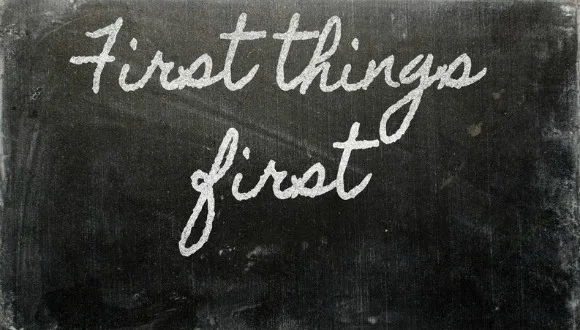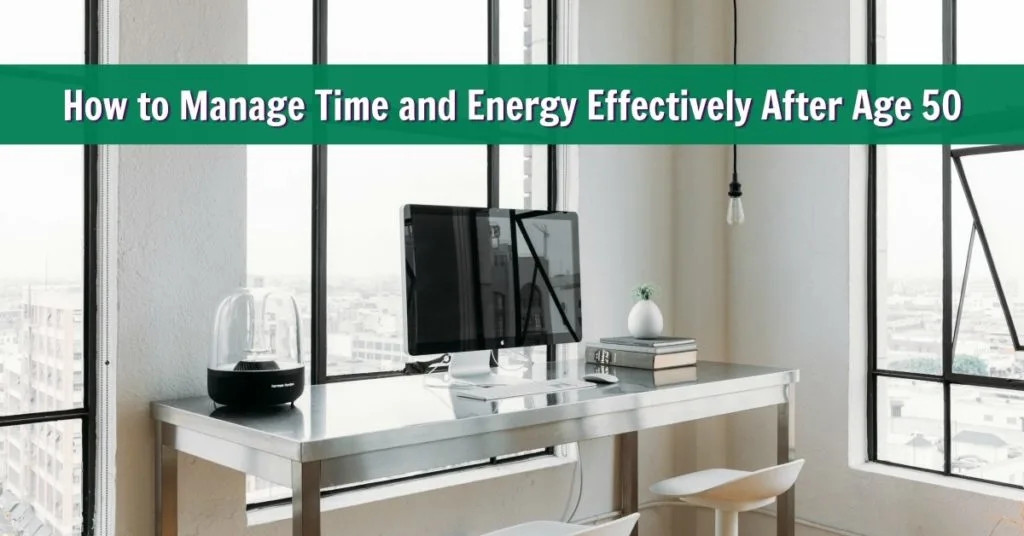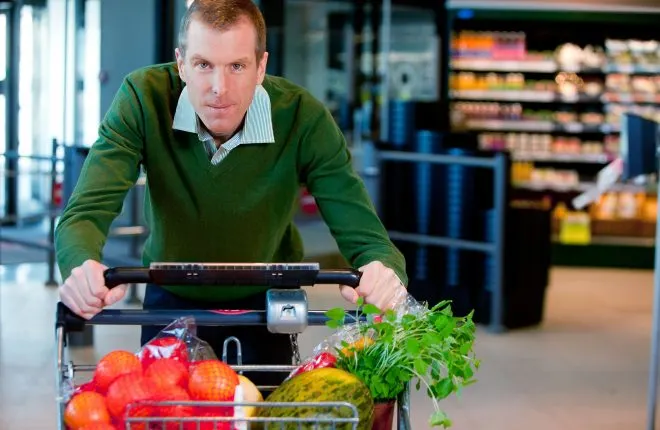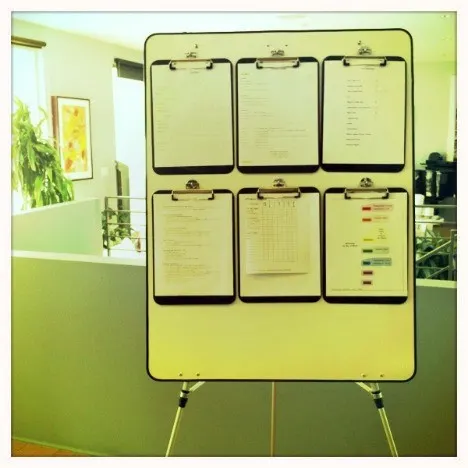Your time has never been more valuable. Focus your energy on the areas that matter most to you and offer the best return on your investment. These 14 time and energy management techniques will help you get more done in a typical week than you ever thought possible. The included video will motivate you to make these new habits stick.
Our priorities shift with age.
As we mature, we realize more fully that our time on earth during this lifetime is not limitless, and each day matters.
You can become unstoppable during the second half of your lifespan!
1. Sharpen Your Awareness of Time
You might be convinced that you know how you spend your time and energy during a typical day – but do you?
It’s essential to sometimes pull back to a higher-altitude view of your life, and instead of working “in” your day, you work “on” the day itself to determine where, when, and how you’re expending your time and energy.
Each of us has the same 168 hours in a week.
Some of us, however, use those 168 hours more optimally than others.

Each hour counts more when you’re using your time and energy optimally because it moves you steadily toward your short-term and long-term goals.
It also means that you work so effectively that you can allocate a larger percentage of those 168 toward the activities you feel passionately about and that bring you joy.
There are enough hours in the day to do everything you want to do; you just need a new perspective.
2. Say “Yes” Less Frequently
Most of us like to think of ourselves as nice people, but sometimes we have to say “no” to people and situations that do not serve our higher purpose:
- say “no” to purchases of material items you don’t need that are just going to clutter your home or office and require dusting and maintenance
- say “no” to social invitations when you’re already behind on your sleep and your other self-care protocols
The person most responsible for taking care of you is… you.
It’s perfectly okay to be fiercely protective of your physical energy. This is a fundamental success strategy and an integral part of time and energy management.
Ironically, you will have more to offer the world if you set healthy boundaries and say “no” to things.
3. Understand that Time and Energy Are Paradoxical
Sometimes, the tasks you think are most productive are real time-wasters, and conversely, sometimes, the activities you think are the biggest time-wasters are, in fact, extremely productive.
This is the paradox of time and energy:
- Example A: office meetings are generally believed to be a smart use of time, but it has been relentlessly proven that office meetings are usually too expensive and too inefficient. People attend meetings not having completed their assigned action steps from the previous meeting (probably because they didn’t take meticulous notes), and meetings tend to have ambiguous objectives.

- Example B: many busy people do not meditate regularly because they feel too busy to meditate –they secretly believe it wastes their time and energy. Studies have demonstrated that meditation clears and focuses the mind, increasing mental energy and stamina. People who meditate consistently are better thinkers who are regularly inspired with creative solutions to complex problems.
4. Realize that All Hours Are Not Created Equally
Unless you live in the rural countryside, you must realize that some time-windows are so congested that there’s little point in even bothering.
In many places, if you have to be at work at 9 am, you’ll probably have to leave your house at 8 am to ensure you arrive on time.
That’s two hours a day sitting in the car just getting to and from.
Meanwhile, if you were to leave your house at 6 am, it would only take you 20 minutes.

So why not go to bed earlier, wake up earlier, drive to the gym right near your office, sneak in a morning workout, and then zip to your office nearby?
In the time you would have been just sitting in traffic, you have already gotten your exercise out of the way. From a time and energy management perspective, this is a no-brainer.
Or, if you need to do the family shopping once a week – it will take 2 hours longer if you try to do it on a Saturday afternoon when the lines are the longest and the parking lots are full. What if you run errands on your Wednesday lunch hour instead? You’d save at least an hour and a half in one fell swoop.
5. Prioritize As If Your Life (and Sanity) Depends on It
We all have our priorities.
Some aspects of our lives take precedence over other aspects.
But in the age of increasing abstraction, we can become so overwhelmed that we lose our ability to see our daily lives practically.
When this happens, we go into information overload, and everything is put on a level playing field – filed away under the catch-all category of “tasks.”

The more overwhelmed a person feels, the more every item holding space in his or her mind tends toward equal importance.
Priorities blur.
If picking up your dry-cleaning is on the same list as helping your son with a homework problem – and both are conceptualized as nothing more than tasks that need to be checked off so that you can move on to the next one – something is amiss.
As readers of this site know, I am a huge advocate of checklists. There’s nothing like scratching completed tasks off of your list.
But not all tasks are created equal.
Often, we have default systems of prioritization that skew our relational lives.
As we look at our various task lists, let us remember to periodically step back, step up, and see our lives from a broader perspective.

I suggest first establishing your life’s biggest priorities.
After that, you can break it down into smaller categories: this year’s priorities, the season’s priorities, the month’s priorities, the week’s priorities, and – finally – your day’s priorities.
Next, and most importantly, see if your activities are aligned with these six fundamental priorities:
- honoring your physique so that it can thrive
- honoring your relationship with your spouse so that it can thrive
- honoring your relationships with your children so that they can thrive
- honoring your revenue-producing activities so that your career can thrive
- honoring the relationship with the givers in your life so that your friendships can thrive
- honoring your relationship with the planet so that you can leave it better off than you found it
Intellectually, we already know that not all tasks are created equal, but sometimes we slip into autopilot, and an objective assessment of our lives reflects muddled priorities.
“In the new economy, the most valuable asset you can accumulate may not be money, may not be wealth, may not even be knowledge, but rather, the ability to control your own attention, and to focus.”
– Mark Manson
Human beings express their spirituality and purpose best in practical, earthly ways. There are other priorities in life beyond these six listed above, but start with these six first. They are the fundamentals; returning to them refocuses on what matters most.
Efficiency is like exercise. You’re on a roll for a while, working out daily, then something happens – you get a cold or have to leave town for a wedding – you miss a couple of sessions, and before you know it, you’ve fallen off the horse altogether.
But you know what? That’s just a natural part of life.
It doesn’t mean fitness training (or productivity systems for improving your efficiency) aren’t for you, it simply means that we all fall off the horse occasionally, and we have to find a way to climb back on quickly – without overthinking it.
When you make a to-do list of one-off items, craft it in order of priority.
Don’t just look through the list and try to mentally grab which tasks are most important for today.
Commit to a prioritized list, so you’re not tempted to waste time and energy on easier or less-important tasks.

Nothing is more rewarding than ticking a box at the end of completing a task and seeing your list of items get smaller. It’s hugely motivating and even pleasurable.
Organizing is one of life’s most important skills.
An essential aspect of organizing is differentiating between tasks that seem important and tasks that will have a long impact.
Imagine a typical day for you. It’s morning, and you have arrived at your desk; you know you’ve got your to-do list around here somewhere – oh, there it is – and now: where do you start?
If you’re like most people, you start with:
- the task on your list that seems the most enjoyable
- or you start with a task that’s not even on your list, but rather, some “fire” that someone has brought to you – in an email, phone, or in person – asking you to put out
Sounds familiar, yes?
The truth is that prioritizing your day is easier – much, much easier – when you follow a couple of basic rules.
One smart place to begin is by tackling the task on your list that has been sitting there the longest.
The idea is that the sense of accomplishment you get from knocking a dusty old task off your list first thing in the morning becomes rocket fuel to help propel you through a terrifically productive day.
And you know what? It works.

Another option for kickstarting your day productively is choosing first that single task from your long list that is the most potentially revenue-producing.
You have a list because you have an idea of what you want your life to look and feel like.
Your goal is, essentially, to succeed.
One of the barometers by which success can be measured is – you guessed it – revenue.
I encourage you to look at your list through the lens of revenue and start prioritizing your tasks based on what you see.
When it comes to our to-do lists, sometimes we can lose focus by working through the list items in the order they were written or some other arbitrary method, rather than thinking about why they are on the list.
Focusing on a revenue-producing activity first will remind you of one of the primary reasons you arrived at your desk in the first place.
Sometimes a list item will jump out at you as potentially profitable.
For instance, sending out an invoice to a client that has an obvious dollar amount attached or depositing a check at the bank (hey, don’t laugh; when I help my friends or colleagues get their offices organized, I have discovered more un-cashed checks stuffed in the back of desk drawers than you would possibly believe).
“20% of the tasks on your checklist will give you the largest return for your energy investment.”
However, usually, revenue-producing tasks are not so obvious.
Tasks such as sending out a resume, writing a hand-written thank you note, or returning a faulty item to the office supply store – are potentially revenue-producing activities, too.
Any activity encouraging clients or customers to recommend others to you is also potentially revenue-producing.
Remember that spending quality time with loved ones is a priority – backburner them at your own risk.
Setting aside a little time and energy for enrichment and self-education is also important. Each week, you can read a book or article that motivates or teaches you to optimize your life.
Remember, once you have completed that first task in a deliberate, strategic, and conscious way, you will have begun your day with a profitable action step – and this is energizing.
Knowing that you’ve already “made it rain” in the morning will boost your day and give your working life more vigor.
In time, you will notice a sense of satisfaction, achievement, and increased profitability.
6. Simplify (Using the Pareto Principle)
20% of the tasks on your checklist of things to do deserve 80% of your energy.
It’s called The Pareto Principle (also known as The 80-20 Rule) and is named after an Italian economist Vilfredo Pareto who, in 1906, observed that 20% of the pea pods in his garden contained 80% of the peas.
The Pareto Principle feels almost like natural law operating in the universe because it seems to apply to almost all situations.

Although Pareto couldn’t skip the seeding and watering of the ineffective pea pods and produce that productive 20%, we can examine how we spend our time and energy.
When you look objectively at how you spend your time and energy and pay close attention to your working practices, it’s astounding what you can discover.
The Pareto Principle can be applied to everything in business and pleasure.
Look through your task list, examine which of the items on your checklist could augment your prosperity, health, or joy when completed – and select those few vital tasks first.
This will allow you to put greater care and attention into the remaining 20% of tasks. Microsoft applied the Pareto Principle to fixing software bugs on the 20% of features that are most often used. They sorted out 80% of the bugs people would experience.
- 80% of the world’s income is owned by the richest 20% of the world’s population
- 80% of profits come from 20% of customers
- 80% of healthcare resources are used by 20% of patients
- 80% of sales come from 20% of sales staff
- 80% of crimes are committed by 20% of criminals
- 80% of profits come from 20% of the time you spend.
There are many success principles at play within the universe, but perhaps the least utilized and understood is the 80/20 rule. It’s a simple concept that can be applied to anything in your life; use it to focus your energies where they will have the most positive impact and the largest return.
Imagine what you could achieve if you aligned with this principle in your work and personal life.
People either enhance your energy – or drain it. Period. End of story.
Who (of the people in your life) seems to contribute most to your sense of well-being, prosperity, or joy? These are the people who should be receiving the bulk of your time and energy. Give to your givers!
If you’ve ever – even for a second – fantasized about what your life would look and feel like if you simplified it, then you may want to align with The Pareto Principle.
7. Use Pre-Printed Lists to Run Errands
Errands are not my favorite thing, yet running errands effectively is essential for a well-organized home and a thriving career.
You might find this odd, but I don’t like shopping. Even clothes shopping, gadget buying, or farmers’ markets – the kinds of shopping most people enjoy – I find a bit tedious.

The video below reveals how I run my once-a-week errands more quickly than most others.
Try as I do to enjoy the process of running errands; it’s just not my favorite activity in the world. I like the results more than the errands themselves.
Organizing expert Maria Gracias suggests that one of the best ways to prepare for errands is to call ahead whenever possible. If there is doubt that the item will be there, then phone ahead of time to verify that the item you need is in stock or ready to pick up.
Also, the best way to ensure that your reusable plastic, paper, and canvas grocery bags are ready for errands day is to return them to the trunk of your car immediately after you unload your groceries and shopping items.
Here’s how to run your weekly errands in the shortest time possible: before you start your car and drive away for an afternoon of errands, pause, breathe, and look around.
If you want to have a great errands experience, it’s worth a few moments to collect your thoughts and verify that you have everything you need to have a good trip before you depart:
- is your water bottle refilled?
- do you have the addresses of any new places you’re going to?
- do you have all your lists?
- is your phone with you?
8. Use Productivity Tools to Help You Manage Your Time and Energy
I remember as a child coveting Batman’s utility belt.
Seemed like that belt – and the tools it carried – got him out of a lot of scrapes and helped his life to work better.
“…if errands stress you out, change how you tackle them. Schedule your time, plan your route, set an errand day, and organize the process. You’ll get more done, and feel better doing it” – Maria Gracia
Everyone needs a few productivity tools to assist in the noble endeavor of becoming more self-efficient.
Your tools might be super high-tech or as simple as a kitchen timer or a clipboard. What’s important is that you find tools that work uniquely well for you and are fun for you to use.

Having tools you enjoy will keep you using them time and time again. Here are a couple of examples that might intrigue you.
You might be shocked to find how much time you spend on the day’s activities – such as commuting, sleeping, or grooming yourself.

Perhaps the best time management diaries are the ones that pair up with your calendar, allowing you to see your tasks and appointments together.
This may seem nerdy or frivolous, but the fact is that the most successful people periodically take an objective look at where their time is going. They are always fine-tuning their schedules and energy allocation. You can, too.
Here’s one tool that can help you track how you’re spending your hours. It automatically sums up the time you’re spending on daily tasks.
By logging your week’s activities, you can see what’s taking too much of your time and take more accountability for fitting in exercise or passion projects.
My168hours.com is a website named after the number of hours in the week which offers a simple time management spreadsheet for you to print out and log your hours. On the site they make a very good point:
“…if you want to lose weight, you keep a food diary. If you want to get out of debt, you record your spending. Likewise, if you want to use your time better, you should keep a time log” – my168hours.com
Using the free my168 spreadsheet can help to make you aware of how much time you spend on each activity and allow you to see more clearly what is the best use of your time (creator Laura Vanderkam also has a book called 168 hours on freeing up your schedule).
9. Think Like a Fortune 500 Executive
Recent research by the International Center for Management and Organization Effectiveness revealed four positive productivity habits engaged in by the world’s top company executives:
- rise early (7 am might be too late)
- workout daily (a minimum of 45 minutes of exercising each morning)
- spend 25 minutes each day on strategic planning and goals
- allocate 30 minutes daily for personal development and self-improvement.
Among those four habits, strategic planning is the least utilized and understood.
Many employees, managers, executives, and entrepreneurs don’t invest time in learning how to improve their personal productivity because they fear too much time will be “wasted” on it.
They believe themselves too busy working in their business to work on it.
They fail to understand that for every minute spent smartly planning, they will save four minutes down the road. That’s a very worthwhile return on investment.
“Each minute of smart planning = 4 more minutes saved”
One of the qualities that set successful executives apart from those who perform more poorly is the high performer’s innate understanding that both physical energy and hours are finite resources.
10. Stop Pretending that Your Time and Energy are Limitless
The most brilliant executives use checklists, so why doesn’t everyone use them?
People hate being told what to do – that’s probably the primary reason most people don’t use checklists consistently, even though checklists make life easier and more enjoyable.
The genius of checklists is that, when properly structured, they help us better manage our time and energy.
Of course, it’s not that checklists are telling us what to do; it’s just that it sometimes feels that way to us because when we look at a checklist, we hear in our minds, “You should do this, and you should do that.”
And no one likes to hear the word should.
It’s nice when you can enjoy a serene mind and be present fully in each moment, but the reality is that most people are not serene or fully present.
Most people are just reacting to their day, putting out fires and drifting away from their primary intention.
Our souls might be timeless, but this particular life you live on earth is quite limited.
You can get a calculator, and based on your parents’ age, lifestyle habits, and location, you can estimate how much time you have left.
You can also deduct hours that must be allotted for sleep from that number, and you’ll see the number gets much smaller.
Hopefully, this realization incentivizes you to see time as your most valuable resource.
Another trick that might incentivize you is to pretend that time is only allocated in 15-minute chunks.
I’ve been deeply interested in time and energy management for many years, and I’ve noticed that many tasks and activities take 15 minutes.
A lot of activities that we think take 5 minutes take 15 when you factor in everything.
Of course, some tasks take more time, and some take less, but 15 minutes seems to be the average for most people (especially for habitual, daily tasks).
When you divide the remaining years of your life (minus sleep) into 15-minute windows, you will understand even more deeply what a precious resource time is.
Choose your 15-minute windows carefully.
Not only do we have limited time each day, but we have limited energy.
Our brains can only make so many choices each day.
This is why – if you truly want to live a self-actualized life in which you achieve your full potential as a human being – it’s a good idea to have a system for negotiating the unnatural chaos of modern daily life. Whatever checklist system you use, I encourage you to find one and utilize it.
Checklists are life-improving. If you approach them with the right attitude, checklists will help you to create extra space for more joy and prosperity to enter your life.
What’s funny about our internal response to checklists is that it’s a complete projection of our anxieties onto a friendly tool – a tool that’s only there to help us. For this reason, it’s extremely helpful to have a sense of humor when using checklists.
Checklists can help us stay on track with projects, preventing the day from drifting away from us.
Checklists help us get more done faster so we can spend more quality time with our loved ones.
To improve your self-care and increase your health protocols, you must find the best schedule and the time and energy for it.
Checklists also create more free time at the end of the week to spend time pursuing our hobbies and those activities for which we feel the passion.
Checklists help us to excel professionally, making us more competitive in our careers and more appealing to our clients and customers (generally, people feel as though they’re in good hands when they engage with someone cheerful, organized, and highly productive).
It’s just human nature – our unconscious can detect these abilities in other people, and we are drawn toward that.
11. Use a Timer
In this digital age, a world of distractions is at your fingertips, and it can be difficult to remain focused on a task or project.
Your friends’ status updates – always just a click away – can provide a tempting diversion from your important work. But social media is often the least of your dangers. With phone calls, inefficient meetings, and people walking past your desk, there is a limitless menu of potential distractions to impede your momentum.
The Pomodoro Technique can help prevent other people’s unintended efforts at derailing your own productivity. It is a simple system that uses a timer.

We hopefully all know that multitasking is mostly a myth.
Multi-tasking means that you’re doing several things at once less effectively.
It’s almost always better to focus your efforts like a laser – for short bursts of concentrated effort.
Everybody has a productivity system, whether they know it or not. For most people, their system is to have no system, to run their day by the seat of their pants.
How you work with time and energy determines whether or not you have a foundation solid enough on which to build outrageous success.
“…winners don’t just learn the fundamentals, they master them. You have to monitor your fundamentals constantly because the only thing that changes will be your attention to them” — Michael Jordan
The Pomodoro Technique can help you strengthen your focus – with just a kitchen timer, a sheet of paper, and a pencil – or a basic smartphone app.
- The first step of Pomodoro is pretty standard to all productivity systems: you write up a checklist of the tasks you want to get done, then prioritize which items you want to complete by placing them at the top of the list.
- However, the second step of Pomodoro is where things get really interesting: you set the kitchen timer to 25 minutes and spend that time concentrating on your task. You do nothing else but this task until the timer rings.
- When the timer rings, check off your task on the list – and reward yourself with a 5-minute break.
- For tasks that take more than one Pomodoro, keep making a checkmark on the paper for every 25-minute interval (be sure to take those 5-minute breaks between each) until the task is complete. This will help you track and process how long things take.
It’s important to periodically ask yourself: “what would my life be like if I were even more organized than I am now?”

- “would I be happier?”
- “would I be richer?”
- “would I achieve my goals more often, and more quickly?”
When you answer those questions, you’ll probably realize that it’s a good idea to re-evaluate your productivity system.
Every person over the age of 11 would benefit by having a productivity system that they use to help themselves become (continually) better organized.
Preferably, that system should be as simple and effective as possible.
Francesco Cirillo developed the Pomodoro technique in the 1980s as a university student.
He named the technique after the tomato-shaped kitchen timer he had when he first developed the system (a fun explanation of Pomodoro is Steffan Noteberg’s Pomodoro Illustrated, which boils the technique down into its simplest parts with cheerful illustrations that are particularly helpful for web developers).
The kitchen timer is a great lo-fi way to cut down on interruptions (although the technically minded might enjoy using a phone app).
Every four Pomodoro sessions, you can take a longer break. Maybe get some fresh air, grab a green juice smoothie, or post a tweet celebrating your productivity.
12. Set Deadlines for Projects
Deadlines are unfortunately named. “Deadline” sounds oppressive and foreboding. Nonetheless, deadlines are important, especially for projects that require a series of related tasks.
It can be hard to stay self-motivated enough to push through when managing your own time and energy.
We all want to be nice to ourselves and give ourselves a break from restrictions like a deadline, but a deadline is very healthy.
Remember, a project is always sexiest in its beginning phases. Many people lose interest during the last 20% of a project. That’s when people lose their momentum and urgency; they take too long to complete the simplest of tasks. They stop checking their work, and things fall through the cracks. Excellence means keeping your momentum going until the very, very, very end.
Put your list, or at least your priority items, in an unavoidable place. Give it top billing. Make it the star of the show. Shine the spotlight on it!

Your productivity system can be paper-and-clipboard, a smartphone app, or whatever works best for you.
Use desktop files or a phone reminder. Or print out your list on your desk. Anything short of a tattoo on your forehead, as long as it helps give your list the energy and attention it deserves.
This is going too far for most of you. Still, I created a special easel for my clipboards (see photo) that I keep right next to my standing desk so that all I have to do throughout the day is glance up and see everything I need – proudly and accurately displayed.
It helps me to stay on track.
For those of you who spend much of your time in the car or traveling from appointment to appointment, you’d probably be better off with a smartphone application, such as Asana.

• Get lean strength and high energy
• Develop supple joints and better posture
• Dissolve brain fog and improve mental clarity
• Reduce visceral fat deposits around the waistline.
Thriving after age 50 requires an inspired plan. My new coursebook is designed for the sole purpose of helping you get healthier quickly. It’s a step-by-step guide for returning to fantastic shape, presented in a strategic sequence. You’ll learn exactly how to eat after the age of 50. Your clothes will fit you better. You’ll feel trim and athletic. Even your skin will improve. Click-through for details.
14. Celebrate Your Time and Energy Successes!
The law of attraction shows us that what we give our time, energy, attention, and focus is eventually amplified.
By celebrating your successes and making a fuss over your accomplishments, The Universe will be compelled to send you more successes.
So reward yourself.
Too many people can be hard on themselves and choose the stick over the carrot.
If there’s a small, useful item you want to buy, a restaurant you want to visit, or a new theatrical or speaking event in town, then make it a reward for completing your priority tasks, finishing that project, or getting that bonus.

At the very least, take a moment to pause, close your eyes and breathe, and really be present in the accomplishment and the feeling that accomplishment provides.
We are part of a global civilization that is becoming exponentially more complex.
It often seems that our culture gets more harried with each passing year – with many people feeling frazzled, sleep-deprived, and disorganized.
The addition of virtual reality into our everyday lives has spread us even thinner. We are acquainted with more people than ever before. We can, and do, have instantaneous communication with people living 12,000 miles away.
As civilization increases in complexity, our daily lives – both real and virtual – respond by also becoming more complex.
It sounds like the plot of a science fiction film.
In reality, it’s just a fact of capitalism in the digital age. Companies are competing for the psychic space of individuals.
And it’s not just corporations competing for your attention; Tik-Tok-ing, Googling, emailing, and texting inundate us on equally staggering curves.
The implications down the road are a giant question mark. The rate of information doubling simply renders prediction – an act based on extrapolation of current norms – impossible.
Let’s take a gander at some of the numbers:
- 1 A.D.: From this point forward, the first doubling of all available information did not occur until 1500 A.D.
- The next doubling occurred around 1750…just 250 years
- The next doubling occurred around 1900…just 150 years
- The next doubling was 1950…just 50 years
- The next doubling was 1960…just 10 years
- Then 1967…just 7 years
- Then 1973…just 6 years
- By 1982, the rate was every 3 years.
- By 1990, the rate was every 18 months
Today, it would be rather conservative to estimate that we experience more change in a year than was previously experienced in a millennium.
Historically, information doubling is the stuff that shifts paradigms (it’s an interesting exercise to look at the above dates and match up the corresponding historical shifts).
“Winning the day” means getting enough of the right tasks completed, so you fall asleep with a deeply satisfying feeling of accomplishment.

Additional Sources on Managing Time and Energy:
Laura Vadnerkam Thinks You Have Enough Time – http://lauravanderkam.com/books/168-hours/manage-your-time/
The Busy Trap – http://opinionator.blogs.nytimes.com/2012/06/30/the-busy-trap/
The Mayo Clinic on Time and Energy Management – http://www.mayoclinic.com/health/time-management/wl00048
Acquaintances and Dunbar’s Number – http://en.wikipedia.org/wiki/Dunbar’s_number
Mark Manson on Attention – http://markmanson.net/attention#cYwpzr:AkVu
Batman’s Utility Belt – http://en.wikipedia.org/wiki/Batman’s_utility_belt

8 Strategies to Increase Your Daily Stamina - Over Fifty and Fit
Saturday 5th of May 2018
[…] position requires you to maintain a certain level of alertness that makes it harder to doze […]
Over Fifty and Fit
Saturday 10th of March 2018
[…] reason you craft goals is because tracking and achieving goals helps to make you happier at work and improves your personal productivity and […]
Over Fifty and Fit
Sunday 4th of March 2018
[…] my case, I could arrive at my desk earlier and get some outrageously effective work done before the rest of the world got hectic and the emails and calls started flooding […]
Over Fifty and Fit
Sunday 4th of February 2018
[…] And start taking small steps toward getting your daily life better organized. […]
Over Fifty and Fit
Wednesday 31st of January 2018
[…] preparation strategies might be all that are required to move briskly toward success and achieve your new health goal of improved […]